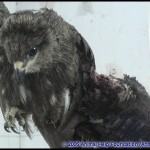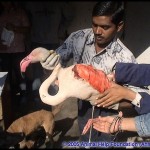AHMEDABAD — As many as a million kites soared aloft over Indian cities on January 15, 2006 as Hindus celebrated Makar Sankranti, the Day of the Sun.
Festivals throughout India featured kite-fighting contests, in which flyers tried to saw through each other’s strings.
Celebrity kite-fighters included Sonia Gandhi, president of the ruling Cong-ress Party, and recently retired former prime minister and Bharatija Janata Party president Atal Bihari Vajpayee, who met in Jaipur.
Everywhere kites rose through the air space occupied by sidewalk and garden bird species such as sparrows and bulbuls, up past ringnecked parakeets and house crows patrolling at treetop height, on to baffle the kite-birds and vultures whose congregations, circling on thermal currents, are often the first sign that Indian airline pilots see of their destination cities, while the cities themselves are still beyond the horizon.
Tens of thousands of temple-goers meanwhile sought to “make merit” by purchasing wild-caught caged birds for ceremonial release, or by throwing out seeds and crumbs for birds in temple squares.
Capturing wild birds for sale and release has been illegal in India since the 1972 passage of the Wildlife Protection Act, but local police rarely make enforcement a priority. The federal and state forest departments do what they can, helped by activist groups with limited powers to make citizens’ arrests.
A hint of the size of the bird release problem came on Decmeber 22, 2005 when forest officers raided the Nakhas bird market in Lucknow, rescuing 739 birds of 15 species, including endangered black-necked cranes, hill mynas, and Lord Derby’s parakeets–and that was just one of thousands of similar locations.
Bird release was practiced at sun festivals by the ancient Egyptians, from whom some Brahmin Hindus believe they are descended. The custom has also been followed by Jains from the beginning of Indian written history, by Buddhists since the time of the Buddha himself some 2,300 years ago, and by Muslims who obey Mohammed’s injunction against keeping caged birds.
When a million kites fly just as hundreds of thousands of dazed, dehydrated, frightened birds are let go, the result is a bird rehabilitator’s worst nightmare.
But the timing is not the worst of it.
Fighter-kites are traditionally flown with cotton threads that have been coated with a paste of glue and powdered glass. The ancient practice of laboriously making “Dor” or “Manja” threads, as they are called in different regions, has yielded to some extent to use of nylon monofilament, which is equally dangerous to birds, but entrants in formal competition–and politicians angling for votes–must use the traditional string preparation recipes.
Historically, Indian and Pakistani kite-flyers made their own equipment. In recent years, however, as Indians and Pakistanis have become more affluent and busier, sales of ready-made kites have reportedly risen at the rate of 20% per year. Mass-produced “Dor” or “Manja” glass-coated threads are available.
More kites are flying, handled by less experienced people, with surprisingly frequent deadly consequences to humans as well as birds. In November 2005, for instance, in Lahore, Pakistan, a 10-year-old girl named Noor died from a slashed throat after a glass-coated kite string dipped into the path of the motorbike she was riding with her uncle.
A five-member panel of the Pakistan Supreme Court headed by Chief Justice Iftikhar Muhammad Chaudhary reported in early December 2005 that more than 450 Pakistanis were killed in kite-related accidents during the year, mostly by falling from rooftops, and that most than 1,500 people had been killed, with 10,000 more injured, since 2000. The panel called for restrictive laws.
Kite-flying peaks in Pakistan at Basant, celebrated in early February. Basant festivals are prominent in the Punjab region, divided between Pakistan and India, and in Multan, whose name means “Land of Birds.”
The military government of Pakistan has since 1999 encouraged Basant kite-flying, despite objections from Islamists who contend that the holiday marks the birthday of a Hindu saint named Basanti Lal.
The Pakistan Supreme Court findings may be seen with skepticism because of the political context, and because thousands of human deaths have not been reported in India.
However, spot-checks of single-day bird tolls could project to tens of thousands. The Jain Bird Hospital in Old Delhi handled 31 kite-injured birds just on Indian Independ-ence Day, for instance, in August 2005.
In Vadodara, to the south, an organization called VCARE on Makar Sankranti 2005 received 23 birds, but could save just four. The Vadodara SPCA saved eight, director Shradda Nar told The Times of India. The Gujarat SPCA in Vadodara, serving the oldest part of the city, received about 20 birds, with possibly no survivors.
The Surat Nature Club took 61 bird distress calls on Makar Sankranti 2005, spokesperson Darshan Desai told Bindu Shajan Perappadan of The Hindu. Eight birds died; more than 30 required wing amputations, and will end their lives in sanctuaries.
Help In Suffering, of Jaipur, fielded 10 mobile units who rescued 117 birds during Makar Sankrani 2006, spokesperson Namrata Tiwari told the Indo-Asian News Service.
“At least 25 birds died on the way while 92 were brought to the centre,” Tiwari said. “After the initial treatment, 59 birds were released while the remaining 33 were still in bad shape, with amputated wings.”
Two other Jaipur animal rescue projects handled 87 birds between them, of whom four died, Indo-Asia News reported.
The biggest program rescuing birds after kite holidays appears to be that of the Animal Help Foundation of Ahmedabad, begun in mid-2000 by then-recent university graduate Rahul Sehgal.
Sehgal’s first goal was just to start a street dog sterilization project, like dozens of others operated under the auspices of the Animal Birth Contol program sponsored by the Animal Welfare Board of India. The Animal Help Foundation ABC project is now among the most successful in the nation–but that was just a start.
Luck of geography put Sehgal and Animal Help closest of any Indian animal welfare organization to the areas worst hit by the January 2001 Gujarat earthquake, which killed more than 30,000 people.
Internationally noted for delivering prompt help to the animal victims, including the work animals and dairy cattle that sustain tens of thousands of human lives in the stricken area, Animal Help also did front-line needs assessment after the Indian Ocean tsunami that hit on December 26, 2004, and led the animal relief response to the monsoon flooding that afflicted much of the region between Mumbai and Ahmedabad in late summer 2005.
Developing a widespread network of contacts throughout central India, Animal Help became involved as well in helping local police and forestry offices to interdict wildlife trafficking, including bird capture and sale for temple release.
From founding, Animal Help has answered animal emergency calls–which soon made kite-flying a focal concern. After Makar Sankranti 2005, Animal Help received reports of at least 600 injured birds, recounts Sehgal. Seven vehicles outfitted as bird ambulances brought 450 avian victims to the newly expanded and renovated Animal Help bird hospital.
Among the hurt birds were black and white ibis, combed ducks, crow-pheasants, peacocks, pigeons, kite-birds, and vultures.
About 80 birds died in Ahmedabad, despite the best efforts of Animal Help veterinarians and 20 volunteers to save them.
“Our telephone lines were jammed during the peak flying hours,” Sehgal told The Times of India. He hoped to be better prepared for Makar Sankranti 2006, making use of the increasing Animal Help stock of experience.
Over time, Sehgal hopes to amend the customs that cause so many bird deaths and injuries. Preventive measures might include a crack-down on bird sales for temple release, restrictions on bird-feeding to avoid conflicts with kite festivals, and restrictions on kite flying to avoid sites that especially attract birds.
Most important, Sehgal says, “People need to stop using glass-coated manja, and learn to fly kites on open grounds.”
Merritt Clifton
Editor, ANIMAL PEOPLE
P.O. Box 960
Clinton, WA 98236
For information on how you can assist:
Help In Suffering
c/o Maha-ani Farm
Durgapura, Jaipur, Rajasthan
302018, India
91-141-760803
fax 91-141-761544
For more information contact:
Animal Help Foundation
c/o #5 Retreat, Opposite Underbridge
Shahibaug, Ahmedabad, Gujarat
380 004, India
91-79 2867698
fax 91-79 2864941







